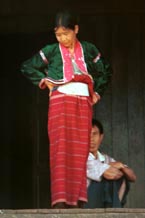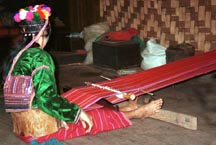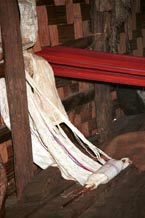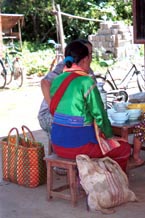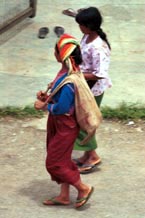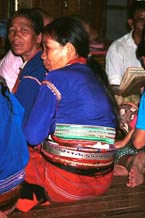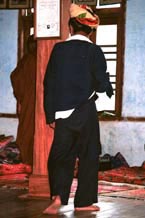 |
||
|
Silver Palaung clothing
all text & images © Pamela A Cross
|
go
to photogalleries of Silver Palaung - Kalaw
market and Pein
Ne Bin village
|
|
There is little written information about Silver Palaung (Pale) and their dress. However, I am indebted to Michael C Howard and Wattana Wattanapun, in their 2001 book “The Palaung in Northern Thailand”, for their survey of existing literature on the Palaung. Richard Diran in his volume "The Vanishing Tribes of Burma" published in 1997 has a few pages devoted to the Palaung (including photos which are clearly of the Pale, taken in the village of 'Pin Ne Bang above Kalaw' which may well be the same Pein Ne Bin village near Kalaw where many of my own photos are taken). Although the accuracy of some of his text may be queried, his photographic record of Silver Palaung dress is helpful. In addition to detailed fieldwork carried out in northern Thailand Howard also visited Kalaw, Shan State, Burma in 1999 and carried out some fieldwork there. The outline below of Silver Palaung dress is based on the description given in Howard and Wattanapun (2001: 65-72) with additional comments hightlighting any differences or additional information as the result of my observations during my visit to the Kalaw area of Shan State in 1998 and recorded in my photos which are used throughout. These and additional photos featuring the Silver Palaung may be accessed via the photogalleries of Palaung - Kalaw market and Palaung - Pein Ne Bin village Silver Palaung women weave on backstrap looms and weaving is reputed to take place either under the house or on the front porch. My own photos of weaving show it taking place inside a house in the village of Pein Ne Bin but it was clear that this was arranged as a demonstration for trekkers visiting the village and was not, at that moment, a spontaneous activity. However, women in the village on the day that I visited during the 'Full Moon' festival were wearing tube skirts which were clearly hand woven. Similarly the skirts being worn at Kalaw market appeard to be handwoven also. See photos of a Silver Palaung weaver in a village near Chiang Mai in northern Thailand taken by Kathleen Forance Johnson in 1998. top Howard and Wattanapun (2001: 67) refer to the back support of the backstrap loom being made of leather in Burma but of plastic rice bags in Thailand (which makes the women's backs sore as it is less elastic). The one I found in Pein Ne Bin village, near Kalaw, Shan State, Burma would certainly appear to be made from animal skin. Howard and Wattanapun state that, in the Kalaw area (2001:65), the Silver Palaung no longer make their own thread but buy commercial thread or yarn in the market in Kalaw although they refer (2001:67) to the Silver Palaung now in northern Thailand having planted cotton and hemp (kateim) and made their own thread when they originally lived in Burma. At that time cotton was used for clothing and personal shoulder bags and hemp for rice bags and other heavier bags. My photos in Kalaw market and of weaving in Pein Ne Bin show examples of the (white) heavier bags but it is not clear whether the thread is cotton or hemp but the probability - especially the bag shown being woven - is that the thread is cotton and purchased in the market. Natural dyes are still sometimes used in Burma, particularly the red used for the women’s tube skirts which is from the root of a local tree. However, increasingly commercial dyes are used, often in the form of pre-dyed thread. In Burma the weaving and production of clothing is seasonal and for domestic use although occasionally in the Kalaw area some textiles are sold to visitors. top The tube skirts are called glahng (with the "ng" sound almost silent). They are made from three pieces of of cloth sewn together using white thread without a separate hem piece or waistband. The Siliver Palaung decoration of the tube skirt seems to be limited to thin coloured stripes in the warp threads - usually white, yellow, blue and green - roughly evenly spaced with a wider band of stripes along one edge of each length. The lengths are is sewn together so that this wider band is at the top, bottom and at hip level of the skirt. Close examination of my various photos shows a considerable variation in the stripes, the widths between them and whether one colour or more are used together in each stripe. It is interesting to note that all of these variations are shown in one group of women sitting eating their meal in Pein Ne Bin village. This would suggest that the variations may be a matter of personal taste rather than identified with specific villages. Howard and Wattanapun (2001:69) refer to plain yellow bands being favoured in northern Thailand by older married women and those with multi-coloured thin stripes by younger women but this does not seem to be obviously the case in Pein Ne Bin village. In Kalaw market I saw a stall where, displayed amongst other items of more traditional clothing, various tubeskirts were for sale. There were some which were in the style of the Silver Palaung handwoven skirts although they were probably not hand woven on backstrap looms. There was a very clear white selvedge band down one edge which was not visible on the skirts which were being worn by the Silver Palaung in Kalaw market or Pein Ne Bin village. The Silver Palaung woman’s blouse is known as a salow and is usually made from commercial fabrics, with shiny and velour fabrics preferred. The blouses are quite short and open down the front without ties or buttons. Those I found in the Kalaw area had the opening held together by a safety pin - similar to one illustrated in Howard and Wattanapun (2001: 66) of a woman in Pang Daeng Nai, Northern Thailand. There is a wide piece of red cloth around the front openings and the back of the neck of the blouse. This red cloth may be decorated or edged with thin pieces of cloth in white, yellow, or other colours. The red material may also be patterned or brocaded fabric. The blouse and the sleeves - at the wrist edge and where the sleeve is set into the bodice - may also be decorated with thin strips of cloth, gold braid or zig-zag lines of stitching in various colours. Sequins, metal disks and strands of brightly coloured yarn may also be used around these edges. The major decorative area on the blouse is a deep band of decoration across the bottom of the back panel of the blouse. top Howard and Wattanapun (2001: 67) refer to there being a tendency for younger women to wear blouses of brighter colours and older women to wear black. I did not see - either in Kalaw market or Pein Ne Bin village - much evidence of older women wearing black blouses. Blue, green and purple seemed to be preferred colours of the main fabric of the blouses pretty much regardless of age. I did not notice any of the Silver Palaung women that I saw in either Kalaw market or Pein Ne Bin village wearing leggings. Howard and Wattanapun (2001: 69) refer to leggings called kabajeng of plain black cotton, tied with a piece of thread, being worn in Burma. One of the key aspects of Silver Palaung dress is the variety of hoops, belts and sashes which the women wear around their waists, particularly the rattan and bamboo hoops. Howard and Wattanapun (2001: 70) refer to an origin legend which is associated with the wearing of the rattan hoops. 'The legend tells that the angel Roi Ngoen came to earth, but was caught in a Lisu animal trap. The Silver Palaung believe that they are descendants of Roi Ngoen and wear the hoops, which represent the trap, to remind them of this. The hoops are also believed to protect the wearer and to bring good luck." top Howard and Wattanapun (2001: 70) describe three types of hoop - thin black lacquered hoops 3 - 4 mm in width known as nong von; wider bamboo or rattan hoops 0.5 - 1 cm in width which have been coloured red known as nong rein; and bamboo or rattan hoops of a similar width which are natural (referred to as "white") decorated with small black circles and are known as nong doan. The diametre of the hoops vary and apparently are adjustable depending on size and taste. My photos in Pein Ne Bin show hoops that are slightly different. The nong doan natural coloured hoops have small white flower like circles with darker centres rather than black circles. Women are also shown wearing bundles of dark threads around their waists under the hoops which have a sheen like silk . Women also sometimes wear a wide metal belt called a nong rurh previously made of silver but now of aluminium. Women also wrap a plain white cotton sash around their waist which is known as a nong roh. None of my photos of Silver Palaung in Kalaw market show any of the women wearing hoops and only a some of the women (who were also wearing the red striped tube skirts) were wearing hoops. The metal belts seem to be even more rarely worn. The white cotton sash seems to be a more standard feature and worn regardless of whether the woman is also wearing any hoops or metal belt. The photos do not show an obvious difference in wearing hoops according to age although none of the very young women were wearing traditional Silver Palaung dress. Although various different forms of head covering have been worn by the Silver Palaung in the past - and are described in Howard and Wattanapun (2001: 70-71) today several women and also some men wear a turban made from either the ubiquitous towels used by various tribes in southeast Asia or other, often plaid, commercially woven cloths. Decorated velvet caps are reputed to be worn by younger, unmarried girls and women. The weaver in my photos in Pein Ne Bin village is wearing one - although she had a husband and child - and I purchased one in the village. However, I did not see any young girls wearing caps and was not convinced that they were made other than for sale to tourists. Richard Diran photographed (in Pin Ne Bang) some girls wearing similar caps to the one shown in my weaving photo and as collected by me in Pein Ne Bin village. His photos also showed married women wearing ornate head dresses of wool and chains rather than towels. He does not indicate the date of his photos in Shan State. top Both Palaung men and women carry shoulder bags made of hand woven cloth. Those that I saw in and around Kalaw tended to be the fairly standard Shan bags made of red ground with thin stripes in blue or green with some yellow in the edge binding. Other variations, available in the market, were also in evidence. Men generally favour western style dress although some wear baggy Chinese style trousers or the longyi or sarong favoured by the majority of Burmese males as everyday dress. Some, generally older, Silver Palaung men wear similar towelling head coverings as the older women. |
|
|
go
to photogalleries of Silver Palaung - Kalaw
market and Pein
Ne Bin village
|
